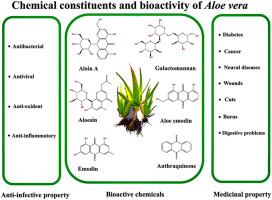Phytochemical profiles, biological activities and medicinal importance of Aloe vera L.: A review
引用次数: 0
Abstract
Aloe vera (Av) is revered in Ayurveda as the "wand of heaven" or "heaven's blessing" and precisely the "silent healer". This herbaceous plant belongs to Asphodelaceae family, previously classified as Liliaceae. In Traditional Chinese Medicine (TCM), Av is acknowledged for its abundant bioactive substances that have considerable therapeutic value. Therefore, the objective of this review is to analyze Av's bioactive compounds, highlighting its medicinal potential in drug development. An extensive literature review is performed utilizing databases such as PubMed, Web of Science, SpringerLink, and more until October 2024. The research investigates the bioactive compounds of Av and their in vivo, in vitro, and in silico effects on infections (bacterial, fungal, viral, and protozoan infections), along with their medicinal properties and significance in drug development. The most investigated active constituents of Av are aloin, emodin, acemannan, and aloesin. Av contains more than 100 potentially active components from six different classes: anthraquinone, chromone, phenylpropanoids, coumarins, phenylpyrone, and phytosterols, focusing on its anti-infective, anti-cancer, anti-diabetic, anti-oxidant, anti-inflammatory, immuno-modulatory activity and impact on neural diseases as well, based on peer-reviewed scientific data. By deepening the understanding of Av's medicinal value, this study may provide a reference for its future research and the development of new bioactive drug molecules from Av.

芦荟的植物化学特征、生物活性及其药用价值综述
芦荟(Av)在阿育吠陀中被尊为“天堂的魔杖”或“天堂的祝福”,确切地说是“沉默的治疗师”。这种草本植物属于藤科,以前归类为百合科。在传统中医(TCM)中,Av因其丰富的生物活性物质而被公认具有相当的治疗价值。因此,本文对其生物活性成分进行分析,以突出其在药物开发中的应用潜力。在2024年10月之前,将利用PubMed、Web of Science、SpringerLink等数据库进行广泛的文献综述。本研究调查了病毒的生物活性化合物及其体内、体外和体内对感染(细菌、真菌、病毒和原生动物感染)的影响,以及它们的药用特性和在药物开发中的意义。研究最多的Av活性成分是芦荟素,大黄素,紫丁香聚糖和芦荟素。Av含有来自6个不同类别的100多种潜在活性成分:蒽醌、色素、苯丙素、香豆素、苯吡咯酮和植物甾醇,重点是其抗感染、抗癌、抗糖尿病、抗氧化、抗炎、免疫调节活性以及对神经疾病的影响,这是基于同行评审的科学数据。通过加深对Av药用价值的认识,本研究可为Av的进一步研究和从Av中开发新的生物活性药物分子提供参考。
本文章由计算机程序翻译,如有差异,请以英文原文为准。
求助全文
约1分钟内获得全文
求助全文

 求助内容:
求助内容: 应助结果提醒方式:
应助结果提醒方式:


